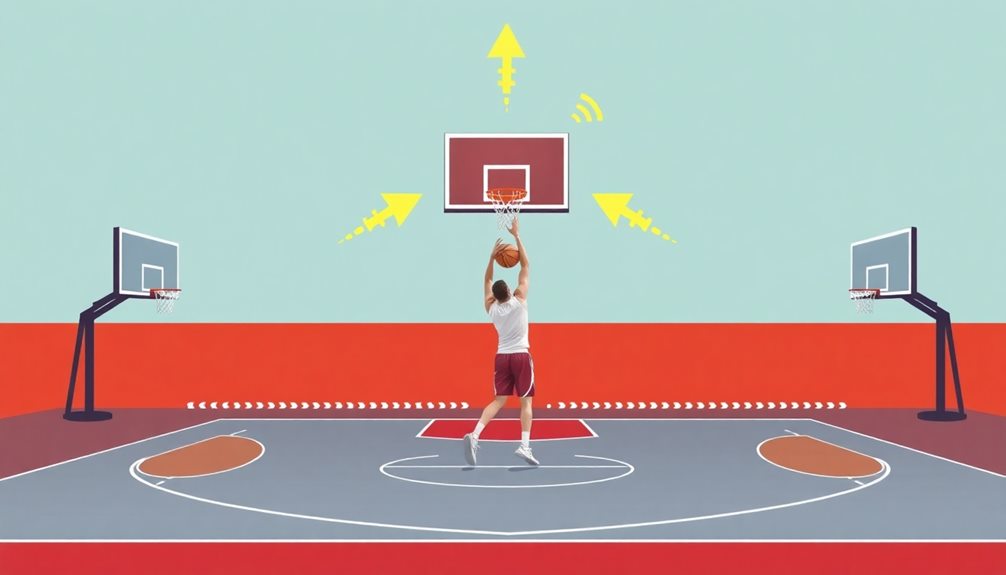
What Does FG Mean in Basketball? Field Goals Explained
December 4, 2024In basketball, "FG" means field goals. These are critical shots made during gameplay, excluding free throws, and can earn your team two or three points, depending on where you shoot from. Layups, jump shots, and three-pointers are common types of field goals. Your team's success heavily relies on field goals, as they constitute a large portion of the points scored. To evaluate a player's effectiveness, you'll often look at their field goal percentage (FG%), which reflects their shooting efficiency. If you're curious about the different types of field goals and how they impact games, there's plenty more to uncover!
Definition of Field Goals
Scoring in basketball revolves around understanding field goals, which are any shots made during play from the court, excluding free throws. A field goal can earn your team either two or three points, depending on how far you're from the basket when you take the shot. This requires you to develop a keen sense of distance and accuracy in your shooting, similar to how advancements in basketball techniques have influenced players' shooting mechanics and scoring strategies over time.
In professional leagues like the NBA and NCAA, the term "field goal" is vital for tracking a player's scoring ability. You'll often hear about a player's career field goal percentage, which reflects their overall shooting efficiency. This percentage is calculated by dividing the total number of field goals made by the total shots taken, giving you a clear picture of a player's consistency.
Famous players like Kareem Abdul-Jabbar and Wilt Chamberlain have set impressive records for field goals made, underscoring the importance of this statistic in measuring a player's success.
Understanding field goals not only enhances your appreciation of the game but also helps you improve your own performance on the court. Keep practicing your shots to increase both your field goals made and your overall scoring contribution.
Types of Field Goals
Field goals come in various forms, each with its own strategic use on the court. You'll often encounter layups and dunks, which are two-point shots taken close to the basket and typically boast a high percentage of success.
Jump shots, on the other hand, are taken while jumping and can vary in accuracy depending on the distance from the hoop. Understanding different soccer formations can also help players develop their shooting angles and positioning on the basketball court.
One of the most exciting types of field goals is the three-point field goal, scored from beyond the three-point line and worth three points. This shot can profoundly impact a game, especially when executed well.
Hook shots, often employed by taller players, involve a sweeping motion and can be effective in close-range situations.
Tip-ins also come into play, allowing players to score by tapping the ball into the basket after a missed shot, often following a rebound.
While free throws don't count as field goals, they provide another scoring opportunity. Understanding these types of field goals helps you appreciate the diverse skills and strategies players use to score effectively throughout the game.
Importance of Field Goals

Field goals are essential to your team's scoring strategy, directly affecting your chances of winning.
By analyzing player performance data, teams can identify effective shot selections that enhance individual performance and overall team dynamics.
When you focus on improving your field goal percentage, you enhance both individual performance and overall team dynamics.
Scoring Strategy Significance
In basketball, understanding the significance of effective shooting is essential for any team aiming for success. Field goals account for the majority of points scored, and your scoring strategy can make or break your game.
Here are three key aspects to reflect on:
- Field Goal Percentage (FG%): A successful FG% directly correlates with your team's offensive efficiency. Aiming for a benchmark of .500 (50%) is vital for strong performance.
- High-Percentage Shots: Focus on scoring strategies that prioritize high-percentage shots like layups and dunks. These successful field goals offer a greater chance of scoring compared to longer attempts.
- Three-Point Shot Evolution: The rise of the three-point shot has transformed the game. Teams now design plays to create open three-point opportunities, maximizing point potential.
Impact on Game Dynamics
Effective scoring not only adds points to the board but also alters the entire dynamics of a basketball game. Field goals are essential since they greatly contribute to your team's total points, with each successful shot earning either two or three points.
When you focus on high-percentage shots, like layups and dunks, you're prioritizing offensive strategies that maximize your scoring efficiency. This is where field goal percentage (FG%) becomes fundamental; it's a key metric that reflects your shooting accuracy and can influence player selections and game tactics.
Teams with the best field goal percentage often enjoy better win-loss records, underscoring the importance of effective shooting. If your team excels in scoring, you can dictate the pace and flow of the game, increasing pressure on your opponents.
Players with the highest career FG% not only enhance their individual performance but also elevate the entire team's chances of success. Ultimately, mastering field goals can shift game dynamics, making scoring accuracy a crucial component in your strategy to dominate on the court.
Prioritizing these aspects can be the difference between winning and losing.
Field Goal Percentage Explained
Field goal percentage (FG%) is a key metric that helps you understand a player's shooting efficiency by comparing made shots to attempted ones.
This statistic is essential in evaluating a player's performance, much like how team composition affects overall game strategy in soccer.
Knowing how to calculate FG% can greatly impact your evaluation of players, as it highlights their effectiveness on the court.
With a higher FG%, you'll see which players consistently make smart shot selections and contribute to their team's success.
Calculating Shooting Efficiency
Shooting efficiency in basketball is often measured by field goal percentage (FG%), a straightforward statistic that reveals how well a player converts attempts into successful shots.
To calculate FG%, you need to keep a few key points in mind:
- Formula: FG% = (Number of Field Goals Made / Number of Field Goals Attempted) × 100.
- Context: An FG% of 40% means a player made 4 successful field goals out of 10 attempts, showcasing their shooting efficiency.
- Standards: The average FG% in the NBA hovers around 45%, with elite shooters often exceeding 50%, indicating higher scoring proficiency.
Understanding your career FG% can provide valuable insight into your performance and help track improvements over time.
Historical data shows that shooting efficiency has generally increased in NBA history, largely thanks to advancements in shooting techniques and analytics.
Players in positions like forwards and centers tend to have higher FG% due to their shot selection, typically taking more high-percentage shots.
Impact on Player Evaluation
A player's field goal percentage (FG%) plays a significant role in measuring their offensive contributions on the court. It's calculated by dividing the number of field goals made (FGM) by the number of field goals attempted (FGA) and then multiplying by 100. A solid FG% of .500 (50%) indicates that a player is making half of their attempts, showcasing their scoring ability. Players with higher averages, typically above 40%, are often seen as more successful offensive players.
When evaluating player performance, FG% becomes essential for teams. They rely on this metric to determine a player's effectiveness, especially when considering trades or drafts. Historical records highlight the importance of FG%, with DeAndre Jordan holding the highest career FG% at 67.3%, and Mitchell Robinson setting a remarkable single-season record at 74.2% during the 2019-20 season.
Additionally, while free throws contribute to scoring, FG% focuses on a player's ability to convert field goals. Understanding field goal percentage not only aids in evaluating individual players but also helps teams strategize for overall success throughout the season.
Historical Records of Field Goals

The history of basketball is filled with remarkable achievements, particularly when it comes to field goals. Some records stand out and showcase the incredible talent and efficiency of players throughout the years:
- Kareem Abdul-Jabbar holds the record for the most career field goals made in NBA history, with a staggering 15,837 successful attempts.
- Mitchell Robinson set the record for the highest single-season field goal percentage at 74.2% during the 2019-20 NBA season, demonstrating his exceptional scoring ability.
- DeAndre Jordan boasts the highest career field goal percentage in NBA history at 67.4%, highlighting his effectiveness near the basket.
In addition to these records, the evolution of shooting techniques and strategies has notably influenced scoring in the game, showcasing the importance of effective exercises for training at home.
These milestones not only reflect individual excellence but also contribute to the overall evolution of the game. Wilt Chamberlain, for instance, occupies the top four spots for most field goals made in a single season, showcasing his dominance during his era.
Additionally, Shaquille O'Neal's remarkable feat of leading the league in field goal percentage for ten seasons further emphasizes the importance of scoring efficiency.
As you explore field goals, these historical records remind you of the game's rich legacy and the players who shaped it.
Scoring Techniques in Basketball
In basketball, mastering various scoring techniques can greatly elevate your game and enhance your team's performance. One essential method is the layup, a high-percentage two-point shot taken close to the basket while you're running toward the hoop. Understanding essential skills and positions can help players create better scoring opportunities.
If you want to impress the crowd, go for a slam dunk. This powerful move showcases your athleticism as you jump and score by putting the ball through the hoop with one or both hands.
Another key technique is the jump shot, which allows you to shoot over defenders by elevating yourself before releasing the ball. You can use this from various distances on the court to keep opponents guessing.
Then there are three-pointers, shots made from beyond the three-point line that require precision and skill. These shots are worth three points and can greatly boost your score.
Lastly, don't overlook tip-ins. This technique involves scoring by redirecting a missed shot into the basket with a quick tap, capitalizing on your positioning and rebounding skills.
Factors Affecting Field Goal Success

How do various factors influence your field goal success in basketball? Understanding these elements can transform your performance on the court. Here are three key factors to evaluate:
- Shot Selection: Choosing high-percentage shots, like layups and dunks, greatly boosts your FG%. A well-timed shot can make all the difference. Additionally, practicing passing techniques can help to create better shooting opportunities for yourself and your teammates.
- Defensive Pressure: When defenders are tight, your shooting efficiency drops. Contested shots limit your space and time, negatively impacting your ability to score. The ability to read the defense and react quickly is vital in this situation.
- Player Fatigue: As the game progresses, fatigue sets in. Tired players struggle to maintain accuracy, leading to a lower shooting percentage, especially in clutch moments.
Additionally, the game's context—like the score and time left—affects your decision-making. Under pressure, you might take riskier shots that hurt your FG%.
The quality of your teammates also matters; better passers create open opportunities, increasing your chances of scoring. By honing your shot selection, managing defensive pressure, and recognizing when fatigue affects your performance, you can improve your overall field goal success and help your team achieve its goals.
Notable Achievements in Field Goals
Basketball history is filled with remarkable achievements in field goals that showcase the skill and precision of some of the game's greatest players. One standout is Kareem Abdul-Jabbar, who holds the record for the most career field goals made in NBA history, with an impressive 15,837 successful shots.
Significantly, Bill Russell's record-breaking 11 championships exemplify how field goals are vital in elevating team success. When it comes to high shooting accuracy, New York Knicks center Mitchell Robinson made waves by setting the record for the highest single-season field goal percentage at 74.2% during the 2019-20 NBA season.
Shaquille O'Neal also deserves mention, as he's the most seasons with the best field goal percentage, achieving this in ten different seasons throughout his illustrious career.
In the WNBA, Diana Taurasi set the record for most field goals made in a single season, hitting 298 shots during the 2006 season. Additionally, Baron Davis made headlines when he sank the longest successful field goal in NBA history from 89 feet away on February 17, 2001.
These records for field goal achievements highlight the exceptional talent and dedication of these athletes, solidifying their places among the career leaders in the sport.
Conclusion
In basketball, field goals aren't just points on the scoreboard; they're the heartbeat of the game, driving momentum and strategy. Understanding their significance can transform how you view each play. Whether you're analyzing a player's performance or enjoying a game with friends, remember that every shot counts. Just like a painter chooses each brushstroke carefully, each field goal shapes the final masterpiece of the match. So, next time you watch, appreciate the artistry behind those vital shots.


